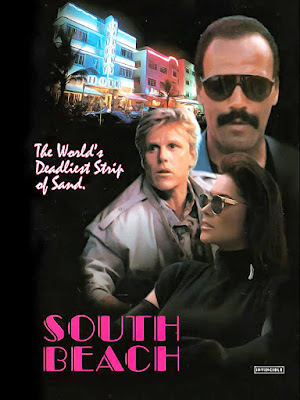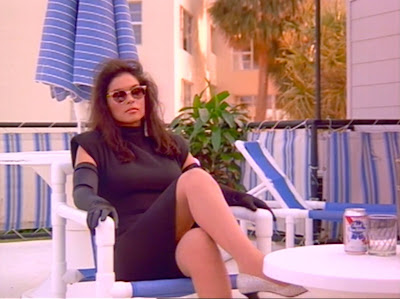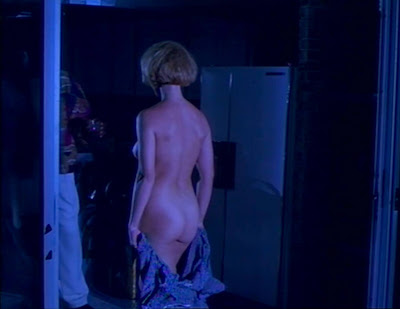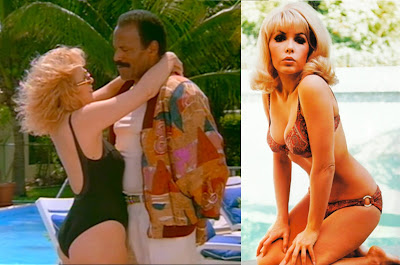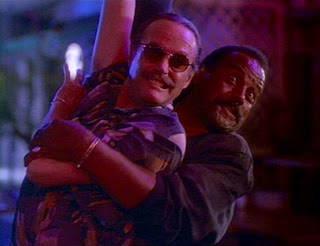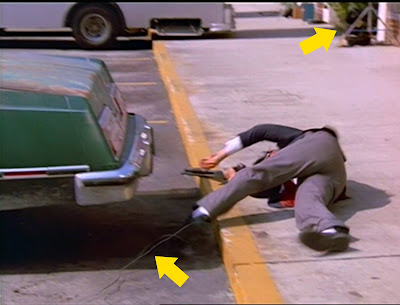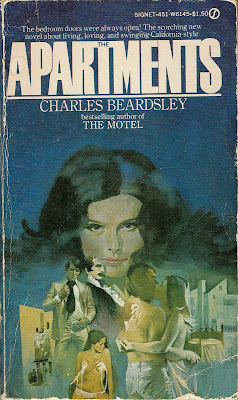 | |||
| Me thinks the cover artist was working from a one-paragraph synopsis, not the actual manuscript. |
In a swinging California apartment complex where anything went, these desperate men and women sought to fill the aching void in their lives with the pleasures of the flesh — and the apartments exploded in an orgy of dark desires and scorching shock!
The Apartments is down to fuck! Well, how could a whore like me resist?
Alas, once I got the novel alone it never could quite get it up, for while the novel was promoted as detailing all the bed-hopping at a Bay Area apartment building, Kumquat Gardens (yes, really), the cover copy neglects to mention the numerous unsexy chapters about the building’s older residents grappling with aging, retirement, poor health and their imminent mortality. But I get it: old people bitching about the cruelties of aging doesn’t make for enticing promotional copy (“In a swinging California apartment complex, senior citizens grudgingly anticipate death”). Yet the cover copy also fails to mention the killer loose on The Apartments’ grounds, a pretty significant omission considering people like reading about murder almost as much as—if not more than—they like reading about sex.
I can’t blame the Signet marketing team for taking the easy way out and just hyping the book’s sexier parts. Lord knows I struggled on how best to synopsize the book. On the surface, it looks like a Burt Hirschfeld-style potboiler, with a bunch of different characters brought into each other’s orbit by virtue of being in the same location, à la Aspen or Key West. However, the paths of Beardsley’s characters seldom cross. Making matters worse, they barely exist in the same genre, The Apartments bouncing from sexy soap opera to slice-of-life character study to supernatural thriller and back again.
In the sexy soap opera parts of the novel, we meet Phil and Peggy Carlin, a young-ish married couple whose libidos are so demanding they have turned, quite cheerfully, to swinging. Among their playmates are a pair of vacationing contortionists, Don and (groan) Donaldine (“The air of nonchalance with which Don gave a startling exhibition of autofellatio was enough to make the couple stars of the porno film scene—which is exactly what happened.”); Fran and Fred, whose excessive vocalizations during sex lead Phil and Peggy to refer to them as the Orals; and Pete and Phyllis Begley, whose marriage might not survive their swinging lifestyle (“I never realized when I voted yes on Proposition Orgasm that I’d feel soiled,” complains Phyllis).
Of course, there are rules to Phil and Peggy’s extramarital activities, chief among them being “no single sex for either partner outside the weekly quartets.” However, when Peggy encounters Ahmad, the hunky Iranian student who lives in Apartment 12, she begins to wonder if rules weren’t made to be broken.
Another sexy soap opera storyline involves young Midwesterner Lane Larrabee and the man of his dreams, Shaw Wing, whom Lane jokingly calls the Incredible Doctor Oh Man Screw, because Shaw is Chinese and political correctness hadn’t yet been invented when this novel was written. More significant than Shaw’s ethnicity (about which Beardsley makes a huge fucking deal) or sexuality (treated rather matter-of-factly) is his being an asshole. He not only agrees to an arranged marriage with Carol, to please his traditionalist parents, he does not tell Lane about it until after the wedding. Though marrying someone behind your partner’s back seems like a justifiable cause to burn all his shit on the front lawn, Lane agrees to continue a clandestine affair with Shaw, getting together for lunchtime trysts while Carol is at work. But when Carol gets pregnant, Lane realizes he’ll always be Shaw’s side piece. Again, Lane could just dump the bastard. It’s not like he couldn’t find another man (dude, you live just minutes away from San Francisco). Instead, Lane plots to get rid of Carol by any means necessary — only to discover Carol has plans of her own.
Moving to the novel’s slice-of-life dramas, we have middle-aged Beatrice Ohara, who’s been in a bad mood ever since her husband went to visit his family in Japan and never returned. Living and caring for her sharp-tongued 83-year-old mother, Miss Maerose, only makes Beatrice more embittered. Needless to say, she’s not pleasant company. Her mother, a former madam, is more entertaining: “I shall take my cane and rise and show all of you soft-ass idiots that I’m from tough pioneer stock and not daunted by the likes of old age.” However, a fall during a walk on the apartment grounds lands Miss Maerose in a convalescent home, where she—and Beatrice—awaits her death. But Miss Maerose isn’t going without getting the last laugh.
Also living amongst the middle-class residents of Kumquat Gardens is multi-divorced, fabulously wealthy Madeline Chabot, because, as we all know, rich people just love living near the less affluent. Madeline is also a busybody, and she’s decided to make retiree Shelby Dick her next project (and possible romantic partner), his poor heart and small bank account be damned.
Meanwhile, octogenarian Dean Meredith, a former reporter, gets sidetracked from writing a follow-up to his bestselling memoir when he receives threatening letters urging him to drop the project if he values the lives of his family. Though this story thread develops some real tension as Dean searches for the source of these threats, Beardsley quickly deflates it, choosing to emphasize Dean’s “betrayal” of his wife, Crystal, by keeping these threatening letters from her.
Rounding out the slice-of-life dramas is Luise Gerber, a middle-aged college professor and obsessive dream interpreter about whom you will not give one fuck, and Noah Langford, an aspiring artist, paid by his wealthy parents to stay away from them, whose art projects include following random people then writing about what he witnesses—a stalker’s journal as art—and a gallery “show” during which he jacks off inside an enclosed wooden ramp as gallery patrons mill about.
Finally, under the heading of supernatural thriller/WTF, we have Fog, the spirit of a Costanoan (a.k.a. Ohlonean) out to possess someone so he can avenge the murder of his pregnant wife by Spanish settlers, a murder that occurred in the same spot where Kumquat Gardens now sits. It’s all pretty dull—until the killing starts.
A Literary McMansion
Beardsley has a gift for characterization, and there are moments in The Apartments that suggest he could’ve easily turned it into a biting satire of early ’70s culture. He’s not an untalented writer, but he is an unfocused one. The Apartments doesn’t read like a cohesive novel but rather like seven or eight different novellas spliced together and stuck under one roof, forming an ungainly literary McMansion. He’d have done better to jettison the more boring characters (bye-bye Luise) and make Fog’s murder-spree-by-proxy the narrative’s driver while expanding on the tawdry lives of the apartment building’s more interesting residents. Also, maybe reconsider Kumquat Gardens as the building’s name?
Perhaps my biggest frustration with The Apartments is its squandered potential as great trash. It’s as if Beardsley is trying to split the difference between his literary pretensions and commercial greed. As a result, many of the “dirty” parts are disappointingly tame (alas, the building can’t be dubbed Cum-Twat Gardens), while the more serious character studies are long-winded and pointless.
I bought The Apartments shortly after reading a positive review on Charles Beardsley’s 1978 novel, Marina Tower, on the now dormant The Ringer Files blog (are you OK, Kurt?). The Ringer Files’ high opinion of Marina Tower was enough to convince me to give Beardsley’s work a try. This was more than five years ago.
In the interim Joe Kenney posted a less enthusiastic review of Marina Tower on Glorious Trash. Though I don’t agree with many of the political views that creep into Joe’s reviews, his take on Marina Tower pretty much mirrors my takeaway on The Apartments (and thus, through trash fiction, common ground is achieved). In fact, based on the Glorious Trash synopsis, Marina Tower is pretty much The Apartments relocated to Los Angeles, so if you’ve read one you don’t need to bother with the other.
And I won’t be bothering with another Beardsley paperback anytime soon, no matter how hard the cover tries to seduce me. I didn’t hate The Apartments, but it didn’t exactly make me want to move in, either.

